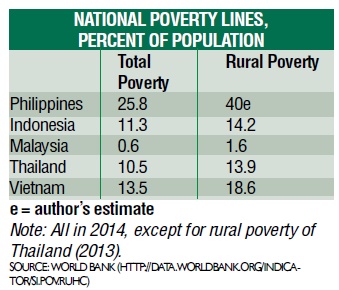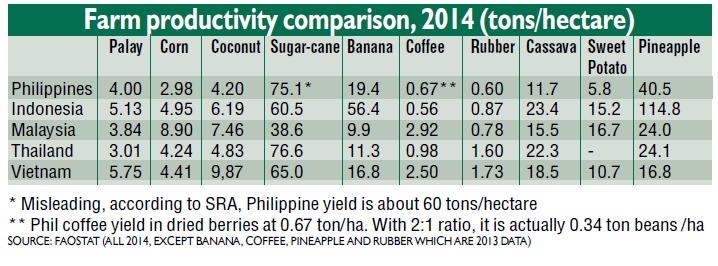Memo to presidential aspirants on mass poverty
WOULD you want to leave behind an enduring legacy? Would you want to be remembered as one of the best Presidents ever? So many Presidents have tried, but failed.
Go for the jugular. Go for REAL INCLUSIVE GROWTH. Lick mass poverty in the countryside. In doing so, there will be social cohesion and more dynamic consumer markets.
Facts. In 2014, the government estimated that nearly 26 percent of Filipinos (25.8 percent to be exact) were poor. Today, that will be about 26 million out of 100 million Filipinos. Of the total poor, about 20 million are in the rural areas, or two out of five of the rural population. These are mostly farmers, fishers and landless workers.
The Philippines failed miserably compared with Asean neighbors, especially Indonesia, Malaysia, Thailand and Vietnam in poverty reduction. Poverty incidence in the Philippines is up two to three times.
Causes and effects. Ragnar Nurske (1907-1959), an Estonian economist, concluded that in the vicious circle (cycle) of poverty, low investment arises from low income, which is due to low productivity. Low productivity is caused, or partly caused, by low investment.
Nurske pioneered the balanced-growth theory. The theory espouses that a government of an underdeveloped country needs to make large investments in a number of industries simultaneously. This will make the market bigger, increase productivity, and encourage the private sector to invest.
He was for attaining balanced growth in both the industrial and agricultural sectors. He believed that the expansion and inter-sectoral linkages between agriculture and manufacturing are necessary so that each of the sectors provides a market for the products of the other and, in turn, supplies the raw materials for the development and growth of the other.
Productivity concerns. The high rural poverty in the Philippines is well-explained by benchmarking farm productivity in Asean. The Philippines has among the lowest ranking key crops, except banana and pineapple. Sugarcane yield is highly overstated as compared to the data of the Sugar Regulatory Administration (SRA). Philippine palay yield is higher than Thailand’s but the latter produces high-priced rice, two to three times the price of ordinary rice.
From 1986-2014, Philippine agri growth averaged 2.4 percent a year as compared to Indonesia’s 3.3 percent and Vietnam’s 3.6 percent. Malaysia had lower growth of 2.3 percent and Thailand 2.4 percent, but these two countries already have a higher base in 1986 (World Bank data).
Agri-food manufacturing accounts for about 10 percent of gross domestic product and nearly half of total manufacturing. The import-dependent industries are doing well, such as biscuit, snack foods, processed meat, and beverages. They have little raw material constraints. But the locally dependent industries are faced by raw material scarcity and have to resort to imports, such as cocoa, coffee, palm oil and rubber. The agri-food manufacturing sector, a major source of jobs, can grow faster with better material base.
Competitiveness is measured by how the country penetrates the global market. The Philippines is a laggard among Asean peers. Its agri-food export of $6.7 billion in 2014 is way behind Indonesia’s $38.8 billion, Thailand’s $38.4 billion, Malaysia’s $26.2 billion and Vietnam’s $24.8 billion. It is also the only country with a trade deficit. What causes this? It is the widespread low farm productivity and limited product diversification.
How can the vicious cycle of poverty be broken? How can the next President move some 20 million rural folks out of poverty? Address farm productivity and supply chains. Adopting and applying advance and appropriate technologies and increasing investments in the countryside are vital.
Farming systems are important. Farm consolidation, such as what is now being adopted in the Asean countries and China, would shape up the countryside. In China today, some 20 percent of the farmlands are consolidated (Jikun Huang, China Academy of Agriculture Sciences, 2012). Policies, like allowing freedom of leases of land-reform lands and lifting retention limits of five hectares on land ownership, would bring more investments.
Adoption of advanced technologies can only be the result of robust management system, good research and development, sound extension service, and investments in infrastructure. Management continuity through a competent bureaucracy is a must.
A grand coalition advocating the advancement of agriculture and fisheries calls for a presidential debate that will give the candidates more time to speak about their platforms for the sector. The coalition, led by Alyansa Agrikultura, includes the Philippine Chamber of Agriculture and Food Inc., (PCAFI), Coalition for Agriculture Modernization in the Philippines (CAMP), Pambansang Koalisyon ng Kababaihan sa Kanayunan (PKKK) and Agriculture Fisheries 2025 (AF2025).
Their advocacies include: (1) an effective agriculture bureaucracy that will include road maps and ISO management systems; (2) agriculture and fisheries councils that ensure the active participation of stakeholders, especially in crafting and monitoring the agriculture sector budget; (3) support of 17,000 agriculture extension workers under the local government units; (4) improve access to farm credit and insurance; (5) subsidies and technical support to make agriculture globally competitive; and (6) that farmers and fishers actually benefit from initiatives, such as agrarian reform, fisher resettlement program, competitiveness-enhancing measures, and use of the coconut levy.
The tasks ahead are difficult. Problems have accumulated in the past decades from President Ferdinand Marcos to President Benigno Aquino III. To undo the current system will take strong political commitment and decisive actions.
But the rewards are high, including uplifting millions and giving them dignified lives. Will the political and economic elite allow this new era?
Bill Gates once said: “It’s been proven that of all the interventions to reduce poverty, improving agricultural productivity is the best. All the other different economic activity—yes it trickles down. But nothing as efficiently as in agriculture” (International Agriculture and Food Security Briefing sponsored by Farmers Feeding the World, 2013).
(The article reflects the personal opinion of the author and does not reflect the official stand of the Management Association of the Philippines or MAP. The author is the Vice Chair of the MAP AgriBusiness and Countryside Development Committee, and the Executive Director of the Center for Food and AgriBusiness of the University of Asia & the Pacific. Feedback at <map@map.org.ph> and <rdyster@gmail.com>. For previous articles, please visit <map.org.ph>)


